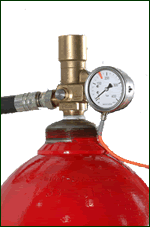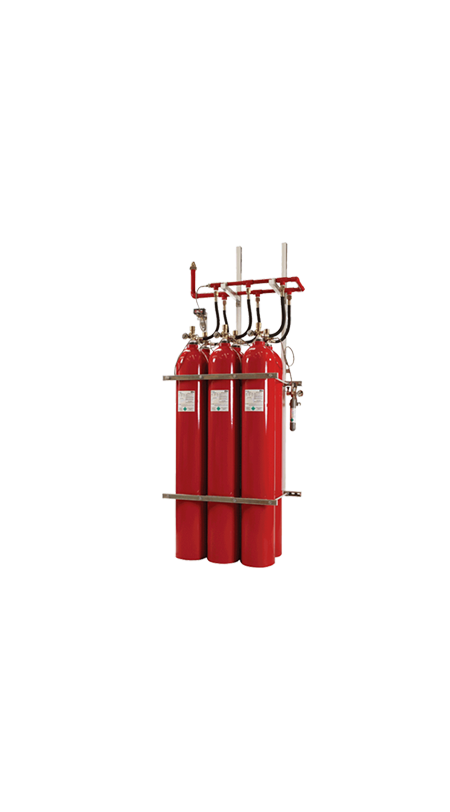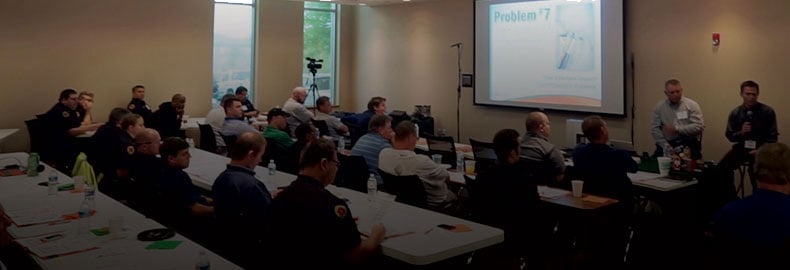Pro-Inert IG-55
ProInert is an inert gas mixture of Nitrogen and Argon. Both substances are naturally occurring and present in the atmosphere. ProInert is safer for use in occupied spaces and poses no threat to the environment, because it has no ozone depletion potential and no direct global warming potential.ProInert extinguishes by means of reducing the oxygen  content within a room to the point at which a ProInertfire can no longer burn, bit without compromising the safety of individuals present. IG-55 must be used in total flooding applications where the protected hazard is enclosed, or for protection of equipment that is self-enclosed in order to maintain the agent after discharge. There are no toxicica factors associated with the use of ProInert. ProInert will not decompose or produce any by-products when exposed to a flame from a fire condition.
content within a room to the point at which a ProInertfire can no longer burn, bit without compromising the safety of individuals present. IG-55 must be used in total flooding applications where the protected hazard is enclosed, or for protection of equipment that is self-enclosed in order to maintain the agent after discharge. There are no toxicica factors associated with the use of ProInert. ProInert will not decompose or produce any by-products when exposed to a flame from a fire condition.
ProInert (N2/Ar) uses IG-55 inert gas as the extinguishing media as specified in NFPA 2001. IG-55 is an inert gas mixture consisting of 50% pure argon and 50% pure nitrogen. IG-55 can be used as a total flooding clean agent fire suppression agent protecting hazards against most flammable substances. IG-55 extinguishant is particularly useful where an environmentally acceptable fire extinguishing system is essential, where an electrically non-conductive medium is needed and where people-compatibility is necessary. IG-55 extinguishant can be used to protect a wide range of applications from sensitive electrical equipment to industrial applications using flammable liquids. ProInert is safe and effective for use on many applications—it is well suited for leaky enclosures such as flight simulators, substations, and control rooms and for applications with multiple hazards.
Because IG-55 does not decompose when extinguishing a fire, there are no toxic or corrosive decomposition products created, other than those that may have been released due to the effects of the fire on the materials within the enclosure. The normal residual oxygen value in an occupied space is 20% by volume. The lowest residual oxygen limit acceptable for personnel occupancy over a short period of time is 10%. After discharge of a typical IG-55 total flood system, the resulting residual oxygen level will be between 10% and 15% by volume. While these residual oxygen levels will not support combustion of most fires, personnel within the space will still be able to breath normally This will allow sufficient time for egress, provided that there are no harmful decomposition products from the materials affected by the fire.




 content within a room to the point at which a ProInertfire can no longer burn, bit without compromising the safety of individuals present. IG-55 must be used in total flooding applications where the protected hazard is enclosed, or for protection of equipment that is self-enclosed in order to maintain the agent after discharge. There are no toxicica factors associated with the use of ProInert. ProInert will not decompose or produce any by-products when exposed to a flame from a fire condition.
content within a room to the point at which a ProInertfire can no longer burn, bit without compromising the safety of individuals present. IG-55 must be used in total flooding applications where the protected hazard is enclosed, or for protection of equipment that is self-enclosed in order to maintain the agent after discharge. There are no toxicica factors associated with the use of ProInert. ProInert will not decompose or produce any by-products when exposed to a flame from a fire condition.

